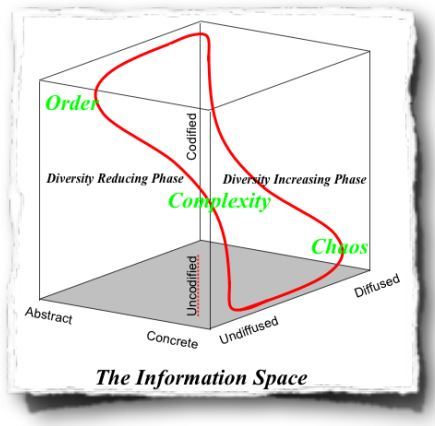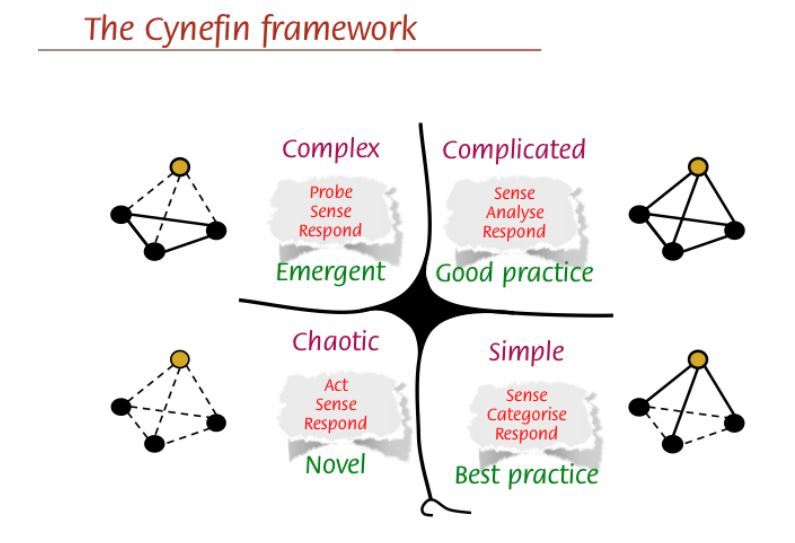H. William Dettmer used this quote in an interesting way – commenting, Dettmer used this to point out how we blindly use popular management tools and techniques in problem-solving. The problem is that we might be using a technique ill-suited for the environment we are in. So, how can we identify our environment in order to apply the right tool? One way to do this is to use the Cynefin framework.
A Sense-Making Framework
Developed by Dave Snowden (not Edward Snowden!), the Cynefin framework is a conceptual way to assist decision makers in making decisions. The word Cynefin (pronounced KUN-iv-in) is a Welsh word for habitat. Dettmer informs us that it is a way to help us visualize and understand how systems operate within a variety of domains. Let’s take a look at how he describes this framework.[1] The external environment describes a continuum from ordered to unordered. The continuum is further divided into general contexts, or domains. It is a sense-making framework helping us make and understand where a system exists among the domains. It helps us identify the correct tools, approaches, processes, and methods that are likely to work in a given domain. It is not intended to categorize as most categorization matrices imply some value judgement about which cell is better. No one cell is more valuable than the other.
Five Domains of the Cynefin Framework
The Cynefin framework is essentially five domains, where four are associated with environmental factors or systems – the fifth domain touches the other four. We can use this framework to identify the state of our knowledge and the state of available information. Another way to look at this is by identifying the state of what is certain to what is uncertain. An understanding of this will assist us in determining which domain we exist in as an organization.
1. Simple
In the Simple domain, systems are stable and we can see clearly the cause-and-effect relationship. Little uncertainty exists in this domain and we are able to make decisions by simply categorizing things. State of Knowledge and Information:
The information is available and we have it. As an organization, we have asked questions and have found the right answers. The “right” answer is easy to identify.
Example of this domain:
Government departments
Tools to use in this domain:
Typical top down command and control system where employees follow a simple standard operating procedure.
2. Complicated
This is the domain of experts. In the Complicated domain you will find that there is no single “right” answer. Dettmer informs us that the philosophy of continuous process improvement is rooted in this domain. State of Knowledge and Information:
We know the information we need, but we don’t have the answers. We have asked but have not received an answer.
Example of this domain:
Auto-manufacturing
Tools to use in this domain:
Lean Six Sigma – DMAIC problem-solving methodology
3. Complex
The best way to determine if you have a Complex or Complicated system is to figure out if you have an emergent or complex adaptive system. Dettmer points out that a complex system will have large numbers of components or agents interacting (as well as learning and adapting). State of Knowledge and Information:
The information we need is out there somewhere, but we don’t know what we’re looking for. We have not asked, but the answer is out there.
Examples of this domain:
Stock Market, Insect Colony, Insurgency
Tools to use in this domain:
Systems Thinking v2.0 (DSRP)
4. Chaotic
This is the realm of the unknown. Here you will find that possessing an understanding of cause-and-effect is almost useless. Dettmer informs us that the recipe for disaster is to wait for patterns to emerge (thus failing to act). In this domain, decisions must be made with no time for reflection. This is also the domain for “moonshot thinkers” and for those who seek to completely destroy (not in a negative way) or change a system or organization. State of Knowledge and Information:
We don’t know what we don’t know. We have not asked because we don’t know what to ask.
Example of this domain:
Attacks of September 11, 2001
Tools to use in this domain:
Mental toughness. Train your mind and body like that of a Navy Seal. Since you have no time to analyze the situation in this domain, you need to be in quick reaction mode here. Leaders must make decisions intuitively in this domain.
5. Disorder
The fifth domain is Disorder – which touches every other domain. This is the realm of the unknown. An organization can slip into this domain at any point in time and from any domain. It is also extremely difficult at times to recognize if you are in this domain. Dettmer provides the following advice if you find your organization has slipped into this domain,
Flow of Ideas
Dave Snowden, developer of the Cynefin framework, discusses the dynamics an organization goes through within his framework and provides the following advice. [2]
To enable the partially constrained flow of ideas, we need to ensure there is good connectivity within the organization, but without central control. Leaders need to stand above the system but not engage with it. As coherence starts to clump, we then shift by recognizing the structure and process of our organization. A pattern of destruction to enable rebirth should be built into your system. After a period of time we should break up the formal group allowing a new knowledge to be created. We should break all links allowing new links to form.
This last point is the one that struck me the most. I thrive in chaos and love to create new things. When I see destruction, I see it as a good thing. I see it as a paradigm shift and a way to bring forth something radically new. This brings to mind a couple examples that could use complete destruction, thus bringing about a paradigm shift in the way we think about them. The first one is that of climate change. The second is a topic I write about extensively – the foster care system. We need to completely destroy how we think about the two and how we operate within them. Lastly, I will leave you with Albert Einstein ‘s advice, Featured photo credit: By Akshat Rathi via qz.com


